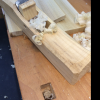So I'm preparing to apply finish to my piece- I used hand planes for the first time on it. I did a wipe down with naptha and noticed a strange appearance to the surface- it looks like each pore in the wood is an oval sequin that I can see. I put some naptha on a board from the same batch I had sanded but not planed and it did not exhibit this. I did a quick finish test on the planed board and it exaggerated the effect even more.
It's hard to photograph but hopefully this picture shows what I'm talking about:
poresboard.jpg
I realized I've seen this once before in the corner of another piece in my home, it looks like this- more pronounced and this is the same look I got after applying finish to my own board:
porescabinet.jpg
So what am I seeing here? And what are my options for undoing it, if any?




 Reply With Quote
Reply With Quote






